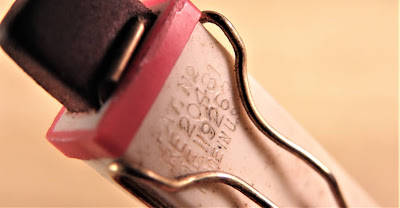This article has been included in The Leadhead's Pencil Blog Volume 7, now available here.
If you don't want the book but you enjoy the article, please consider supporting the Blog project here.
With auction pictures being what they are, and online sellers sometimes garbling their descriptions, I bid on this lot for a closer look:
The seller described them as "Slimcil" pencils. I assumed the seller meant "Slencil," but still . . . these looked different from the early Slencil pencils I've seen. It has been years since I've posted about Carl Harris' early Slencil pencils, because I haven't had anything new to add to the discussion since Volume 1. Here's the image from Volume 1, page 163:
In 2015, I revealed that at some point, the Moore Pen Company was producing the Slencil -- "producing," not necessarily manufacturing, since the tooling was unique to this pencil and if Moore didn't acquire Harris' machinery, Moore was sourcing them rather than making them (see Volume 3, page 236):
I picked up another example along these lines from David Silber at the Raleigh Show this year - the pencil fits nicely into the small Cross box in which it was housed, but without any comparable "Slencil by Cross" sticker, I don't give much weight to any speculation that Cross ever offered these:
Early metal Slencils consistently bear the Slencil name on their reversible eraser retainers, accompanied by two patent numbers:
The first is a design patent for the unique appearance of the pencil. Design patent 93,476 was applied for by Carl C. Harris on July 16, 1934; it was issued October 2, 1934:
The other is patent number 1,975,788, applied for by Harris on April 13, 1933 and issued October 8, 1935:
On May 1, 1936, Harris applied to reissue patent 1,975,788, which was granted on August 24, 1937 as Reissue Patent 20,481. The reissue patent appears on later, conventional "Stag Slencil" pencils, even though the ordinary nose-drive mechanisms in these plastic, rectangular pencils has nothing to do with Harris' patents (see Volume 2, page 247):
Which brings us to this trio of "Slimcil" pencils. When they arrived, I couldn't wait to pull out my loupe to read whatever might be imprinted on them. The seller was correct: "Slimcil / Pat. RE20,481" is imprinted on the clips:
Compared to all the other metal Slencils in my collection, these "Slimcils" are an entirely different animal. Harris' patent drawings show a single piece of metal, folded in half and then folded again at the edges to form a thin barrel. None of my other metal Slencils have this feature, but these Slimcil pencils do (minus the pronounced medial rib to accommodate the mechanism):
While Slencils are slender, Slimcils are skinnier still:
Exactly how these pencils fit into the Slencil story remains an open question. Harris never registered a trademark for "Slimcil" as he did for "Slencil," and all of my searching for when or by whom the name was used are at a dead end. These Slimcils are more true to Harris' original design, but the Reissue patent rather than the original patent number might suggest it was made later -- perhaps after Harris turned over the rights to make his pencils to Moore, he wanted to make some on his own account, changing the name and appearance of the pencil so he wouldn't run afoul of whatever his contractual obligations with Moore might have been.
It is also possible that Harris did not begin production immediately after securing his patent in 1934; perhaps he began production in late 1937, and he filed to reissue his patent to restart the clock for the term of his patent.












2 comments:
I found one of the early thin gold one as you have pictured on Ebay in its box yet no date in box ...but instructions in lid top. Id post a pic....if i knew how to add to this comment. 😑
I have an ivory Slencil that I found in my Dad’s stuff. Was wondering how old it is. Had a place at the top for extra lead.
Post a Comment